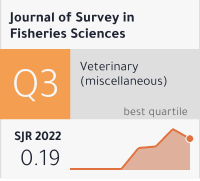Assessment of Heavy Metals in Water, Sediments and Different Organs of Schizothorax labiatus Collected from River Panjkora Dir Upper, Pakistan
DOI:
https://doi.org/10.53555/sfs.v12i2.3657Keywords:
Schizothorax labiatus, Heavy Metals concentration, Water, Sediment, Fish Tissues and Aquatic ecosystem.Abstract
Heavy metals, though essential in trace amounts, pose significant ecological and health risks at elevated concentrations. This study assessed the concentrations of cadmium (Cd), lead (Pb), magnesium (Mg), nickel (Ni), and iron (Fe) in water, sediments, and tissues of Schizothorax labiatus from River Panjkora, Dir Upper, Pakistan. Water and sediment samples (n=9 each) and fish tissues (n=30) were analyzed via atomic absorption spectrophotometry. Results revealed severe contamination, with Pb in water (7.31 mg/L) exceeding WHO limits (0.01 mg/L) by 731-fold, while Ni was undetected. Sediments showed high Mg (7.71 mg/L) and Cd (0.07 mg/L). In S. labiatus, the liver and intestine accumulated the highest metal loads (e.g., Cd: 0.049 mg/L in liver; Pb: 0.58 mg/L in intestine), whereas gills and skin had the lowest. These findings underscore heavy metal bioaccumulation linked to anthropogenic activities (mining, industrial discharge) and highlight urgent needs for pollution mitigation to safeguard aquatic ecosystems and public health.









